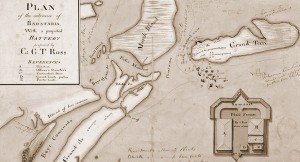The Short-Lived Military Camp on Grande Terre
December 3, 2013 in American History, general history, History, Louisiana History

This is a map drawn by Lafon in 1813 of Grande Terre, showing a proposed military battery which was never built.
Even people who are well versed in Louisiana history probably never have heard of Camp Celestine. The pretty name makes it sound like a Girl Scout gathering place, but in reality it was a failed military post on the marshy dunes of Grande Terre island during May through June of 1813.
British ships had started blockading the Balize at the mouth of the Mississippi River in May 1813 during the War of 1812, and the HMS Herald had been steadfastly harassing shipping to and from New Orleans as the main feature of the blockade. American authorities were worried that the British might get ideas about using the bayou approach to New Orleans plus they wanted to end the smuggling that had been going on from privateers in that area, so they decided to set up a small military garrison on Grande Terre. For some reason, the Laffites and Baratarian privateers were concentrated then more heavily 12 leagues away, on Cat Island near the mouth of Bayou LaFourche, so the American military encountered no obstacles. Militia earlier had been mustered into federal service as the Second Battalion of Louisiana Volunteers, under the command of Major H.D. Peire, and it was members of this force that stood ready to defend the island from the British and smugglers.
On May 6, 1813, Spanish authorities said pirates in an armed boat captured a Spanish schooner below English Turn on the Mississippi River, carried her out through the unguarded Southwest Pass, and brought the prize to Grande Terre, unaware that the Laffites and Baratarians were elsewhere. The captain also didn’t know an American force was present, until it was too late. The prize and cargo were seized, but the pirates escaped in their ship, according to a May 18, 1813, letter about the incident written by Diego Morphy, New Orleans, to Juan Ruiz de Apodaca, captain general of Cuba.
Apparently, other privateers got enough warning to stay away from Grande Terre while the Americans were there, because no other ships were seized. Major Peire decided to take the offense, and make an expedition to Cat Island, using barges filled with all the American forces and supplies. Interestingly, at almost the exact same time, Capt. Clement Millward of the nearby HMS Herald had the same plan, and sent out his launches with about 100 men to attack the Cat Island privateers. The five privateer schooners manned by Baratarians near Cat Island fought back soundly, defeating the British and severely wounding the leader of the British contingent, Lt. Edward Handfield, who had his left shoulder shattered by a musket ball. A squall rose up, and the British boats were separated from their ship; the American forces were near enough to be caught in the storm as well, and the barges upset, losing all the supplies and two of the volunteer militia men. The American men seem to have scattered during the storm, as shortly afterward back on Grande Terre, a court martial convened for a trial of 10 to 15 mutineers and of Major Henry of the Volunteers. Authorities must have looked kindly on these men, for none of them were sentenced to death. Their supplies and guns totally lost, the Americans quickly left Grande Terre to the sand crabs and returned to New Orleans, defeated. Camp Celestine as a military post was now just a minor footnote in history, and the Laffites and Baratarians soon took advantage of this departure and shifted all their operations from Cat Island to Grande Terre, given its closer proximity to New Orleans. The HMS Herald was absent from the Gulf Coast for a couple of months due to damage from a hurricane that hit her home base of Nassau, and when she returned to the Balize, she gave a wide berth to the French privateers.
Recent Comments